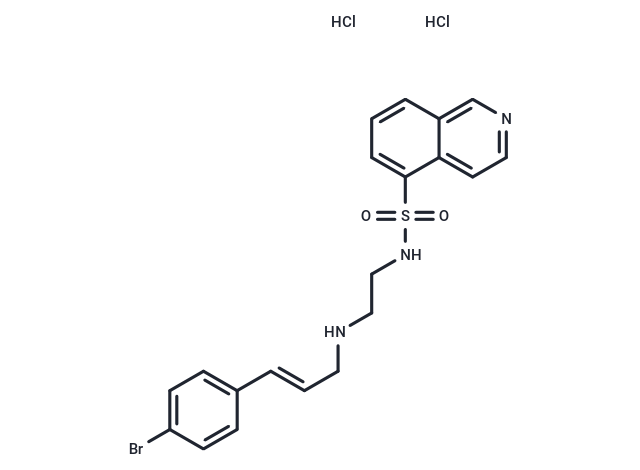 您的购物车当前为空
您的购物车当前为空
H-89 dihydrochloride
一键复制产品信息别名 Protein kinase inhibitor H-89 dihydrochloride, H 89 2HCl
H-89 dihydrochloride (5-Isoquinolinesulfonamide) 是一种选择性 cAMP 依赖性蛋白激酶A(PKA) 抑制剂,IC50值为 48 nM。也可轻微抑制 PKG、PKC 和酪蛋白激酶活性。

H-89 dihydrochloride
一键复制产品信息H-89 dihydrochloride (5-Isoquinolinesulfonamide) 是一种选择性 cAMP 依赖性蛋白激酶A(PKA) 抑制剂,IC50值为 48 nM。也可轻微抑制 PKG、PKC 和酪蛋白激酶活性。
| 规格 | 价格 | 库存 | 数量 |
|---|---|---|---|
| 5 mg | ¥ 318 | 现货 | |
| 10 mg | ¥ 485 | 现货 | |
| 25 mg | ¥ 987 | 现货 | |
| 50 mg | ¥ 1,860 | 现货 | |
| 100 mg | ¥ 3,320 | 现货 | |
| 200 mg | ¥ 4,730 | 现货 | |
| 500 mg | ¥ 7,270 | 现货 | |
| 1 mL x 10 mM (in DMSO) | ¥ 397 | 现货 |
产品介绍
| 产品描述 | H-89 dihydrochloride (5-Isoquinolinesulfonamide) is a potent inhibitor of protein kinase A (PKA; IC50: 0.14 μM, Ki: 48 nM). |
| 靶点活性 | S6K1:80 nM (cell free), PKA:48 nM (Ki, cell free) |
| 体外活性 | H-89对蛋白激酶A具有明显的选择性抑制作用,Ki值为0.048 microM。H-89预处理能够剂量依赖性抑制forskolin诱导的蛋白磷酸化,而对PC12D细胞内环磷腺苷(cyclic AMP)水平无降低作用,NGF诱导的蛋白磷酸化也未被抑制。H-89还显著抑制了PC12D细胞forskolin诱导的突起生长,即使在加入二丁酰环磷腺苷(dibutyryl cAMP)前添加H-89时亦可观察到此抑制效应。在细胞裂解液中,用H-89(30 microM)预处理PC12D细胞显著抑制了cAMP依赖的组蛋白IIb磷酸化活性,但对其他蛋白磷酸化活性无影响[1]。此外,H-89对S6K1、MSK1、ROCK-II、PKBα和MAPKAP-K1b的IC50值分别为0.08、0.12、0.27、2.6和2.8 μM[2]。在大鼠裸露的EDL纤维中,通过离子替代引起的去极化反应仅在10 microM H-89的作用下轻微受抑,该浓度远足以完全抑制PKA。在1-2 microM下,H-89显著减慢了大鼠裸露纤维的重新装填率。用100 microM H-89时,通过离子替代引起的去极化反应力完全被抑制。在小鼠屈指深肌(FDB)单一纤维中,1-3 microM H-89对动作电位介导的Ca2+瞬变无明显影响[3]。 |
| 体内活性 | 不同剂量的H-89(0.05、0.1、0.2 mg/100g)被腹腔内(i.p.)注射,于静脉注射PTZ(0.5% w/v)前30分钟施用。H-89(0.2 mg/100g)的腹腔注射显著延长了PTZ处理动物的发作潜伏期和阈值。用PTX(50和100 mg/kg)预处理动物,减弱了H-89(0.2 mg/100g)在PTZ暴露动物中的抗惊厥效果。H-89(0.05、0.2 mg/100g)阻止了bucladesine(300 nM)的癫痫发作活动,显著增加了发作潜伏期和发作阈值[4]。在OVA致敏/挑战的小鼠中,通过腹腔内(i.p.)注射H89(10 mg/kg)显著抑制了AHR,而对对照组小鼠的气道反应无影响。H89处理减少了嗜酸性粒细胞数量80%、中性粒细胞数量64%及淋巴细胞数量74%,对巨噬细胞无影响。在中度模型中,细胞浸润由39.3%嗜酸性粒细胞、58.5%巨噬细胞、1.9%中性粒细胞和0.3%淋巴细胞组成,且完全被H89抑制[5]。 |
| 激酶实验 | All protein kinase activities were linear with respect to time in every incubation. Assays were performed either manually for 10 min at 30 °C in 50 μl incubations using [γ-32P]ATP or with a Biomek 2000 Laboratory Automation Workstation in a 96-well format for 40 min at ambient temperature in 25 μl incubations using [γ-33P]ATP. The concentrations of ATP and magnesium acetate were 0.1 mM and 10 mM respectively unless stated otherwise. This concentration of ATP is 5–10-fold higher than the Km for ATP of most of the protein kinases studied in the present paper, but lower than the normal intracellular concentration, which is in the millimolar range. All assays were initiated with MgATP. Manual assays were terminated by spotting aliquots of each incubation on to phosphocellulose paper, followed by immersion in 50 mM phosphoric acid. Robotic assays were terminated by the addition of 5 μl of 0.5 M phosphoric acid before spotting aliquots on to P30 filter mats. All papers were then washed four times in 50 mM phosphoric acid to remove ATP, once in acetone (manual incubations) or methanol (robotic incubations), and then dried and counted for radioactivity [2]. |
| 细胞实验 | After 48 h in culture, PCl2D cells are cultured in a test medium containing 30 μM H-89 for 1 h and then exposed to a fresh medium that contained both 10 μM forskolin and 30 μM H-89. Cells are scraped off with a rubber policeman and sonicated in the presence of 0.5 mL of 6% trichloroacetic acid. To extract trichloroacetic acid, 2 mL of petroleum ether is added, the preparation mixed and centrifuged at 3000 rpm for 10 min. After aspiration of the upper layer, the residue sample solution is used for determination [1]. |
| 动物实验 | H89 (N-[2-(p-Bromocinnamylamino)ethyl]-5-isoquinolinesulfonamide], di-HCl Salt) (10 mg/kg) suspended in 5% DMSO in saline was administered i.p. two hours before each OVA challenge (or two hours before the last OVA challenge). Control animals received equivalent volumes (200 μl) of 5% DMSO in saline [5]. |
| 别名 | Protein kinase inhibitor H-89 dihydrochloride, H 89 2HCl |
| 分子量 | 519.28 |
| 分子式 | C20H20BrN3O2S·2HCl |
| CAS No. | 130964-39-5 |
| Smiles | Cl.Cl.Brc1ccc(\C=C\CNCCNS(=O)(=O)c2cccc3cnccc23)cc1 |
| 密度 | no data available |
| 存储 | Powder: -20°C for 3 years | In solvent: -80°C for 1 year | Shipping with blue ice/Shipping at ambient temperature. | |||||||||||||||||||||||||||||||||||
| 溶解度信息 | H2O: < 1 mg/mL (insoluble or slightly soluble) DMSO: 104 mg/mL (200.28 mM), Sonication is recommended. | |||||||||||||||||||||||||||||||||||
| 体内实验配方 | 5% DMSO+95% Saline: 3.16 mg/mL (6.09 mM), Solution. 请按顺序添加溶剂,在添加下一种溶剂之前,尽可能使溶液澄清。如有必要,可通过加热、超声、涡旋处理进行溶解。工作液建议现配现用。以上配方仅供参考,体内配方并不是绝对的,请根据不同情况进行调整。 | |||||||||||||||||||||||||||||||||||
溶液配制表 | ||||||||||||||||||||||||||||||||||||
DMSO
| ||||||||||||||||||||||||||||||||||||
计算器
体内实验配液计算器
以上为“体内实验配液计算器”的使用方法举例,并不是具体某个化合物的推荐配制方式,请根据您的实验动物和给药方式选择适当的溶解方案。
剂量转换
对于不同动物的给药剂量换算,您也可以参考 更多




 很棒
很棒
 |
|